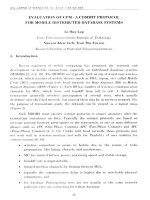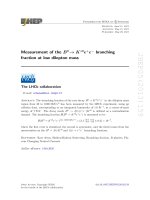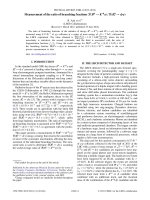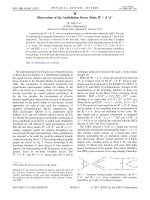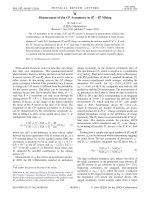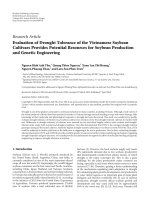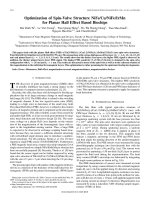DSpace at VNU: Evaluation of Drought Tolerance of the Vietnamese Soybean Cultivars Provides Potential Resources for Soybean Production and Genetic Engineering
Bạn đang xem bản rút gọn của tài liệu. Xem và tải ngay bản đầy đủ của tài liệu tại đây (6.43 MB, 10 trang )
Hindawi Publishing Corporation
BioMed Research International
Volume 2014, Article ID 809736, 9 pages
/>
Research Article
Evaluation of Drought Tolerance of the Vietnamese Soybean
Cultivars Provides Potential Resources for Soybean Production
and Genetic Engineering
Nguyen Binh Anh Thu,1 Quang Thien Nguyen,1 Xuan Lan Thi Hoang,1
Nguyen Phuong Thao,1 and Lam-Son Phan Tran2
1
School of Biotechnology, International University, Vietnam National University HCMC, Quarter 6, Linh Trung Ward,
Thu Duc District, Ho Chi Minh City 70000, Vietnam
2
Signaling Pathway Research Unit, RIKEN Center for Sustainable Resource Science, 1-7-22 Suehiro-cho, Tsurumi,
Yokohama 230-0045, Japan
Correspondence should be addressed to Nguyen Phuong Thao; and Lam-Son Phan Tran;
Received 6 February 2014; Revised 28 February 2014; Accepted 3 March 2014; Published 7 April 2014
Academic Editor: Alberto Reis
Copyright © 2014 Nguyen Binh Anh Thu et al. This is an open access article distributed under the Creative Commons Attribution
License, which permits unrestricted use, distribution, and reproduction in any medium, provided the original work is properly
cited.
Drought is one of the greatest constraints to soybean production in many countries, including Vietnam. Although a wide variety of
the newly produced cultivars have been produced recently in Vietnam through classical breeding to cope with water shortage, little
knowledge of their molecular and physiological responses to drought has been discovered. This study was conducted to quickly
evaluate drought tolerance of thirteen local soybean cultivars for selection of the best drought-tolerant cultivars for further field
test. Differences in drought tolerance of cultivars were assessed by root and shoot lengths, relative water content, and droughttolerant index under both normal and drought conditions. Our data demonstrated that DT51 is the strongest drought-tolerant
genotype among all the tested cultivars, while the highest drought-sensitive phenotype was observed with MTD720. Thus, DT51
could be subjected to further yield tests in the field prior to suggesting it for use in production. Due to their contrasting droughttolerant phenotypes, DT51 and MTD720 provide excellent genetic resources for further studies underlying mechanisms regulating
drought responses and gene discovery. Our results provide vital information to support the effort of molecular breeding and genetic
engineering to improve drought tolerance of soybean.
1. Introduction
Soybean (Glycine max L. Merrill), primarily produced by
the United States, Brazil, Argentina, China, and India, is
currently considered as one of the most important oilseed
crops all over the world [1]. Surprisingly, the world’s biggest
soybean consumers are the East Asian and Pacific countries,
including China, Japan, Thailand, and Vietnam. Soybean’s
consumption as food products and animal feeding materials
in Vietnam has radically grown in the last few years because of
its widely recognized health-related benefits [2–4]. According
to the statistics of 2012 from the United States Department
of Agriculture, Vietnam produced approximately 270,000
tons of soybean with a total cultivated area of 180,000
hectares [5]. However, the local soybean supply only meets
18% nationwide demand due to low soybean productivity
that predominantly resulted from abiotic stresses of which
drought is the major constraint [6]. This is also a great
challenge for the plant productivity many countries are
facing, especially in arid areas where water resource is more
restricted [7–10]. Therefore, gaining a better understanding
of the mechanisms regulating plant adaptation to drought
for maintaining plant growth, development, and productivity
in water deficit regions is an important goal of many plant
biologists and breeders worldwide [11]. In case of soybean
production, drought severely affects soybean growth and
development and may cause yield loss by approximately
40% in the worst year [10, 12, 13]. Each year, Vietnam still
2
has to import 2.5 million tons of soybean [6]. As a result,
development of soybean elite cultivars, which can sufficiently
cope with water scarcity, has been an important task for
soybean research community in Vietnam [14]. Thanks to
soybean breeder’s efforts, many soybean hybrid cultivars with
improved productivity under drought have been recently
developed by different research institutions and applied
across the country [6].
A number of assessment methods have been exploited
to quickly examine drought tolerance ability of soybean
cultivars under stressed and nonstressed conditions based on
their root and shoot growth rates [15]. It is well established
that root length is one of the primary traits that support
plants to tolerate the limited water conditions [16]. Thus,
analyzing dynamics of root growth under severe drought
conditions is important to specify the contribution of roots
to drought adaptation [17]. In soybean, roots are distributed
in the top soil when water is sufficient, but under water deficit,
extensive root growth and development occurs deeper in the
soil profile [17, 18]. Early establishment of the root system
(seedling vigor) could be one of the important traits in the
selection of soybean genotypes for improvement of soybean
production in drought-prone areas [12]. Shoot growth rate of
soybean is reduced by drought during vegetative growth and
early reproductive development. However, soybean plants
with strong drought-tolerant ability can be recovered after
rewatering for certain days [19]. It has been reported that
studies on plant stress physiology not only provide valuable
information for agricultural practices and water-saving control but also enable identification of contrasting cultivars used
in screening for candidate genes for development of improved
drought-tolerant crops by genetic engineering [12, 13, 20–22].
Until recently, little research has been undertaken to examine
phenotypic differences concerning drought tolerance among
Vietnamese soybean cultivars. In a recent study, Ha et al.
[23] have assessed the water loss and the shoot and root
growth rates of an improved drought-tolerant local soybean
cultivar (DT2008) and the reference cultivar Williams 82
(W82) under normal and drought conditions, but this study
was limited due to the small number of tested varieties [20].
In this study, thirteen local cultivated varieties and the
reference W82 were assessed under normal and drought
conditions to reveal their morphological and physiological
variations in response to water shortage. The objectives were
to determine quickly which cultivar(s) possesses the best
drought tolerance which might be suggested to be used
in soybean production and to identify the most droughtsensitive and the most drought-tolerant cultivars from investigated phenotypes for further screening for differentially
expressed drought-responsive candidate genes by expression
analysis. Our results suggest that DT51 is the highest droughttolerant cultivar, while MTD720 is the lowest one among all
the cultivars examined. Thus, DT51 can be recommended to
be used in farm production in the country, and these two
contrasting cultivars, DT51 and MTD720, can be subjected to
further differential studies to gain an insight into regulatory
mechanisms of drought response and to identify useful genes
for engineering soybean plants.
BioMed Research International
2. Materials and Methods
2.1. Plant Materials. In this study, 13 Vietnamese soybean
cultivars collected from Can Tho University (MTD176,
MTD720, MTD751, MTD765, MTD772, MTD775-2, and
MTD777-2) and Vietnam Legumes Research and Development Center (DT20, DT22, DT26, DT51, DT84, and DT96)
were used along with the reference phenotype W82.
2.2. Net House Conditions and Cultivation Techniques. All
plants in the present study were cultivated inside a net house
that helped to maintain a consistent temperature range (28–
30∘ C) and a relative humidity (60–70%), together with a
photoperiod of 12 h light and 12 h dark conditions. Initially,
one seed was sown at 2 cm depth in each plastic tube with
parameters specified below which was filled with a premixed
standard potting soil. Irrigation was thoroughly undertaken
every single day to ensure the distribution of identical water
amount for individual plant.
2.3. Examination of Root and Shoot Growth at Seedling and
V3 Stages under Well-Watered Conditions. Two screening
methods using two different tube systems described in [24]
were applied to examine physical growth of plants at certain
stages under well-watered conditions. For seedling stage
assessment, 30 plastic tubes (40 cm in height and 6.5 cm in
diameter) were adhered to a tray representing each cultivar.
After 12 days of planting, each tube was cut longitudinally in
order to safely isolate the whole root system from potting soil.
On the other hand, the V3-stage assessment (21 days after
sowing) was implemented with also 30 plastic tubes (80 cm
in height, 10 cm in upper diameter, and 6.5 cm in bottom
diameter)/cultivar.
2.4. Drought-Induced Treatments. Sixty 4-day-old seedlings/
cultivar grown in plastic tube system (80 cm in height
and 10 cm in diameter), which have relatively the same
height, were selected for drought-induced treatment. Regular
irrigation was discontinued after 12 days of planting to
initiate the 15-day-drought treatment. Soil moisture contents
(SMC) were monitored at 5-day intervals (𝑛 = 3) using
moisture balance (Shimadzu, Japan). For control, another
set of plants was maintained from each variety under wellwatered conditions. After 27 days of planting, the whole root
systems from both drought-treated and well-watered groups
were gently removed from soil for measurement of physical
lengths and dry matter (DM).
2.5. Assessment Methods. Taproot and shoot lengths of each
plant (𝑛 = 30) were measured immediately after its removal
from soil. For determination of root and shoot dry matters
(𝑛 = 30), the whole root and shoot systems were kept in
drying oven at 65∘ C for 24 h before being weighed using
an analytical balance (Satorius, Germany). Relative water
content (RWC) of 27-day-old plants treated with drought
was measured as described in [23]. The aerial parts of plants
(𝑛 = 15) developed under both well-watered and drought
conditions were measured to determine the sample fresh
BioMed Research International
3
(a)
b
DT84
b
(b)
0.9
0.25
bcd
cde cde
de de de
0.1
abcd
bcde
bcde
abc
ab ab
e
ab abcd
abc ab abcd a abcd
0.05 bcd abcd abc
bcd bcd cd
d
Shoot dry matter (g)
a
0.7
0.6
0.5
bcd
bcd
bcd bcd
0.4
0.3 ab
0.2
bcd
abcd abc
a
ab ab
cd
ab
ab
ab
d ad
ab
ab ab
ab ab ab ab
ab
b
0.1
DT84
MTD777-2
DT26
DT22
MTD765
DT20
MTD751
MTD176
DT96
MTD772
DT51
MTD720
DT26
DT84
MTD777-2
DT22
DT20
MTD765
DT96
MTD772
MTD720
MTD751
DT51
MTD176
MTD775-2
Williams 82
(c)
MTD775-2
0
0
Williams 82
Root dry matter (g)
0.8
a
0.2
0.15
DT51
Williams 82
DT51
DT84
DT26
MTD772
MTD765
MTD751
DT20
MTD777-2
MTD176
MTD775-2
MTD720
Williams 82
0
DT20
10
MTD765
d
MTD751
fg
MTD176
fg efg
MTD772
ef fg
a
d
DT96
g fg
b
c
cd bc
cd cd cd cd
de
de
de
ef f de
b b cde cde bcd a de bc
e
e
f
g
g
MTD777-2
e
20
c
c
DT26
30
cd
ef de
ef
a
MTD775-2
h
40
gh fgh fg
Shoot length (cm)
cd
DT22
50
b
c
cd
DT96
Taproot length (cm)
60
50
45
40
35
30
25
20
15
10
5
0
DT22
a
MTD720
70
(d)
Figure 1: The root and shoot developments at 12-day-old seedling stage (black bars) and V3 stage (grey bars) of 13 soybean cultivars and the
reference cultivar W82 under normal conditions. Roots and shoots were collected individually for measurement of the length and dry matter
(DM) at day 12 after sowing and at V3 stage. (a) Tap root length. (b) Shoot length. (c) Root DM. (d) Shoot DM. Error bars represent standard
error (𝑛 = 30). Different letters indicate significant difference at each developmental stage according to Duncan’s test (𝑃 < 0.05 level).
weight (FW). Subsequently, fully turgid weights (TW) of all
the samples were determined after being soaked in deionized
water overnight and gently wiped with absorbent paper to
avoid extra moisture. The immersion process was undertaken
under room light and temperature. Finally, the plants were
dehydrated at 65∘ C for 48 h to measure dry weight (DW).
RWC was calculated as
RWC (%) = [
(FW − DW)
] × 100.
(TW − DW)
(1)
Drought-tolerant index (DTI) was calculated as described
in [25]. Five seeds of each variety were geminated separately
in each of the 5 plastic tubes (25 cm in height and 30 cm
in diameter) (𝑛 = 25). The plants were maintained under
well-watered conditions in net house. For drought treatment,
water was withheld from 12-day-old plants for 15 days. The
percentage of nonwithered plants was determined after 1,
3, 5, 7, 9, 11, 13, and 15 days after water withholding. After
drought treatment, the plants were reirrigated for 15 days. The
percentage of recovered plants was identified after 1, 3, 5, 7, 9,
11, 13, and 15 days of reirrigation. The drought-tolerant index
of soybean varieties (referred to as a surface of a radar chart,
comprised of multiple axes) was calculated as
DTI =
1
sin 𝛼 (𝐷1 𝑅1 + 𝑅1 𝐷3 + 𝐷3 𝑅3 + 𝑅3 𝐷5 + 𝐷5 𝑅5
2
(2)
+𝑅5 𝐷7 + ⋅ ⋅ ⋅ + 𝐷15 𝑅15 + 𝑅15 𝐷1 ) ,
where 𝐷𝑛 is the percentage of nonwithered plants after 𝑛
day(s) of drought treatment, 𝑅𝑛 is the percentage of recovered
plants after 𝑛 day(s) of reirrigation, and 𝛼 is the equal inner
angle of the radar chart, which is formed by multiple axes (𝐷𝑛
and 𝑅𝑛 ). In this case, 𝛼 = 360/2𝑛 and the number of equal
inner angles (2𝑛) is 16.
2.6. Statistical Analysis. The data were analyzed using SAS
(version 9.13, by SAS Institute, Inc., Cary, NC, USA). Differences among soybean cultivars in separated experiments
were estimated with Proc GLM procedure. Duncan’s test was
subsequently applied to classify the cultivars into homogenous subgroups denoted by common letters. Mean values
4
BioMed Research International
90
80
80
Soil moisture content (%)
Soil moisture content (%)
85
75
70
65
60
70
60
50
40
30
20
10
55
DT84
DT51
DT20
DT26
DT22
DT96
MTD772
MTD775-2
MTD176
MTD751
MTD777-2
MTD720
5th day
10th day
15th day
20th day
25th day
5th day
10th day
15th day
MTD765
Williams 82
DT84
DT51
DT20
DT26
DT22
DT96
MTD772
MTD775-2
MTD176
MTD751
MTD765
MTD777-2
MTD720
Williams 82
0
20th day
25th day
(a)
(b)
Relative water content (%)
90
a
80
b
cde
c c c ccde c
cde cde
ce c
de cde cde cde
a
ab b abab a
ab
b
bcd abc
70
DT51
DT84
DT20
DT26
DT96
DT22
MTD775-2
MTD772
MTD176
MTD751
MTD777-2
MTD720
MTD765
Williams 82
60
(c)
Figure 2: Examination of RWC of 13 soybean cultivars and the reference cultivar W82. For drought treatment, water withholding was applied
to 12-day-old plants for 15 days. SMC was recorded in each pot of each cultivar at 5-day intervals during the measurement of RWC of
the soybean cultivars. (a) SMC was measured under well-watered condition. (b) SMC was measured under drought condition. Error bars
represent standard error (𝑛 = 3). (c) RWC under normal (black bars) and drought conditions (grey bars). Error bars represent standard error
(𝑛 = 15). Different letters indicate significant difference within a treatment according to Duncan’s test (𝑃 < 0.05 level).
were shown on the figures, and error bars represent the
standard errors.
3. Results and Discussion
3.1. Root and Shoot Lengths at Seedling and V3 Stages under
Normal Growing Conditions. In crop plants, root growth is
an important trait because of its essential role in water uptake.
Stable and vigorous cultivars, which can produce their longer
taproots to reach water source from deeper soil layer, would
be considered as candidates that might have better tolerance
to water deficit than those with shorter taproots [16]. Therefore, the root features were used to assess drought tolerance
ability of the 13 local soybean cultivars, whereas the shootrelated traits were used as reference criteria in our evaluation.
The tube system was applied to compare the root and
shoot traits among soybean cultivars in early developmental
stage under normal growing conditions. After 12 days of
seedling stage, significant difference for taproot length was
detected (Figure 1(a)). On the basis of the taproot length
data, 14 cultivars were classified into three groups. Four
cultivars, W82, MTD775-2, MTD751, and DT26, fell into
the medium taproot category (length 19–22 cm). MTD176,
MTD777-2, DT20, and MTD720 were classified as short
taproot length cultivars (length <19 cm), whereas DT51,
DT84, MTD765, MTD772, DT22, and DT96 were classified
as long taproot length members (length >22 cm). Among all
5
90
80.0
80
70.0
Drought-tolerant index (×104 )
70
60
50
40
30
20
10
60.0
50.0
40.0
30.0
20.0
10.0
DT51
DT84
DT26
DT22
MTD765
DT96
MTD772
DT20
Williams 82
MTD176
MTD775-2
MTD751
DT84
DT51
DT26
DT22
MTD765
DT96
MTD772
DT20
Williams 82
MTD176
MTD751
MTD775-2
MTD777-2
MTD720
5th day
10th day
15th day
20th day
MTD777-2
0.0
0
MTD720
Soil moisture content (%)
BioMed Research International
25th day
30th day
35th day
40th day
(a)
(b)
Figure 3: Examination of DTI after drought treatment for 13 soybean cultivars and the reference cultivar W82. (a) For the assessment of the
DTI in soybean cultivars, the SMC was measured at 5-day intervals from germination to reirrigation with drought duration of 15 days. Error
bars represent standard error (𝑛 = 3). (b) DTI values were determined by the percentage of nonwithered and recovered plants after 1, 3, 5, 7,
9, 11, 13, and 15 days of the drought exposure and reirrigation (𝑛 = 25/cultivar).
the soybean cultivars examined, DT51 possessed the longest
taproot length (30.5 cm) and MTD720 showed the shortest
taproot length (18 cm), suggesting that DT51 might have
the highest tolerance capacity, while MTD720 might have
the lowest tolerance capacity to drought. We also observed
a significant difference in shoot length of the examined
cultivars at seedling stage (Figure 1(b)). On the basis of their
shoot length, the tested cultivars could be divided into 3
groups: high (>23.5 cm), medium (22–23.5 cm), and short
(<22 cm) groups. Five cultivars, including DT84, MTD720,
W82, DT26, and DT22, were found to belong to the short
shoot length category. DT20, MTD772, MTD777-2, MTD176,
and MTD765 were classified as medium shoot length cultivars, whereas MTD751, DT51, DT96, and MTD775-2 were
classified as high shoot length cultivars.
During examination of root characteristics at V3 stage
under well-watered conditions, we found that there was
a significant difference in taproot length among the cultivars (Figure 1(a)). According to the results, DT51, DT22,
DT96, and DT84 were classified into the long taproot group
(>50 cm). DT26, W82, MTD772, MTD765, MTD751, DT20,
and MTD777-2 had medium taproot length (40–50 cm).
The remaining varieties, including MTD775-2, MTD176, and
MTD720, showed short taproot length (<40 cm). Among 14
varieties, DT51 exhibited the longest taproot length (59.3 cm),
while MTD720 had the shortest root length (36.2 cm). DT51
also had the highest shoot length, making it a member of the
high shoot length group (>35 cm) that also includes DT84
and MTD765. A number of cultivars, such as DT20, MTD751,
MTD176, MTD772, and DT96, exhibited medium shoot
length (30–35 cm), while MTD720, MTD775-2, DT26, DT22,
and W82 fell into the low shoot length category (<30 cm)
(Figure 1(b)).
These data together demonstrated that DT51, which had
the longest root length and high shoot length, and MTD720,
which displayed the shortest root length and short shoot
length, at both seedling and V3 stages, might be the two
contrasting drought-responsive cultivars.
3.2. Root and Shoot DM at Seedling and V3 Stages under
Normal Growing Conditions. With regard to root DM, our
data indicated that there was a significant difference in root
DM among the cultivars at both seedling and V3 stages
(Figure 1(c)). At seedling stage, high root DM group included
MTD777-2, MTD720, and DT22 (>0.045 g). DT20, DT51,
DT26, MTD751, DT84, and MTD176 had medium root
DM (from 0.035 to 0.045 g), while W82, MTD772, DT96,
MTD765, and MTD775-2 showed low root DM (<0.035 g). At
V3 stage, the high root DM group included DT26, MTD7772, and DT84 (>0.15 g). DT22, DT20, W82, MTD765, DT96,
and MTD772 exhibited medium root DM (0.09–0.15 g),
whereas MTD751, MTD720, DT51, MTD176, and MTD775-2
had low root DM (< 0.09 g). There was a slight difference in
shoot DM among all the cultivars at seedling stage. MTD720,
DT20, DT26, MTD765, and MTD751 had higher shoot DM
(>0.2 g) than others, such as those belonging to medium
shoot DM group, including DT51, MTD777-2, DT84, W82,
and MTD176 (0.18–0.2 g), and those classified into low shoot
DM group, including MTD772, DT96, DT22, and MTD7752 (<0.18 g). Significant differences were recorded at V3
stage (Figure 1(d)). All cultivars could be divided into high
(>0.5 g), medium (0.4–0.5 g), and low (<0.4 g) groups. DT84,
6
BioMed Research International
80
Soil moisture content (%)
75
70
65
60
55
70
60
50
40
30
20
20th day
25th day
(a)
DT51
DT84
DT26
DT22
DT20
DT51
DT84
MTD772
MTD777-2
MTD176
DT20
a
1.2
b
cd h
0.4
g
fg
ef
f
g
g
e
ef
d
e
c
d
a
bc
cd
g
f
f
MTD751
0.6
i
MTD772
0.8
g
DT22
1
DT96
f
f
a
0.2
DT51
MTD765
MTD176
DT20
DT26
MTD775-2
MTD777-2
MTD720
0
DT84
Shoot dry matter (g)
1.4
Williams 82
MTD777-2
DT22
DT51
MTD765
DT26
MTD775-2
DT20
MTD176
MTD751
MTD772
DT84
DT96
MTD720
b
(d)
0.5
ab ab a a
0.45
b
bc
de c
0.4
fg ef de ab
a
ab
0.35
abc
0.3 gcd gbcdg
cd
d
de de
de
0.25
e e e
0.2
0.15
0.1
0.05
0
Williams 82
MTD765
(c)
DT96
Williams 82
DT51
DT26
DT84
DT22
MTD765
DT20
DT96
MTD176
MTD775-2
MTD720
MTD777-2
MTD751
MTD772
Williams 82
0
MTD751
10
DT26
20
DT22
30
MTD775-2
40
50
a
45
b
bc
bcd
40
de de cd
ef ef ef ef e
35
a
a
fg
ab bcd abc cd de
cde
30 g
cde bcd
ef f f
25 g
20
15
10
5
0
MTD720
ab a
de cd bcd abca abca a a
e
e
b
bc b
60 fgb gcd fg f b f
cd
e de
e
50
Shoot length (cm)
Taproot length (cm)
DT96
(b)
70
Root dry matter (g)
Williams 82
20th day
25th day
5th day
10th day
15th day
80
(e)
MTD777-2
MTD775-2
MTD772
MTD765
MTD751
MTD176
DT51
DT84
DT26
DT22
DT20
DT96
MTD777-2
5th day
10th day
15th day
Williams 82
MTD772
MTD775-2
MTD765
MTD751
MTD176
MTD720
10
MTD720
Soil moisture content (%)
80
(f)
Figure 4: The root and shoot developments under normal (black bars) and drought (grey bars) conditions of 13 soybean cultivars and the
reference cultivar W82. For drought treatment, water withholding was applied to 12-day-old plants for 15 days. SMC was recorded in each pot
of each cultivar at 5-day intervals. (a) SMC was measured under well-watered condition. (b) SMC was measured under drought condition.
Error bars represent standard error (𝑛 = 3). (c) Tap root length. (d) Shoot length. (e) Root DM. (f) Shoot DM. Error bars represent standard
error (𝑛 = 30). Different letters indicate significant difference within a treatment according to Duncan’s test (𝑃 < 0.05 level).
BioMed Research International
DT96
MTD765
DT22
DT84
DT26
DT51
DT20
MTD176
MTD720
MTD775-2
Drought condition
MTD777-2
DT51
DT26
DT84
DT22
MTD765
DT96
DT20
(a)
Williams 82
MTD772
MTD751
10 cm
Normal condition
MTD772
MTD751
MTD777-2
MTD720
MTD775-2
MTD176
Williams 82
10 cm
7
(b)
Figure 5: Examination of morphology for 13 soybean cultivars and the reference cultivar W82. (a) Morphology of 27-day-old plants grown
under normal condition. (b) Morphology of 27-day-old plants grown under drought condition.
MTD777-2, DT26, DT22, and MTD765 had high shoot DM,
whereas medium group included DT20, W82, MTD751, and
MTD176. The remaining cultivars (DT96, MTD772, DT51,
MTD720, and MTD772) displayed low value of shoot DM.
These data suggested that the differences in taproot and
shoot lengths are not well correlated with root and shoot
DM. A similar result was observed in previous study of
Manavalan et al. [24]. This might be explained by the fact
that, although a decrease of total DM may be due to growing
conditions, the distribution of biomass may also result from
change in resource pools, leaf senescence, the reduction in
photosynthesis and cell division, and the change in cell wall
composition [16, 26, 27].
3.3. RWC under Normal and Drought Conditions. Evaluation
of RWC of various plants, especially under drought, will
provide information about their tolerance levels in response
to stress conditions [28]. This value highlights potential
cultivars with better tolerance and thus higher yield, which
exhibit higher RWC under drought. Thus, to further examine
the contrasting drought responsive phenotypes of DT51 and
MTD720, we determined the RWC of these two cultivars
together with other local soybean cultivars and W82 during
both normal and drought conditions. The SMC was monitored during drought treatment to ensure the similar SMC
levels among different pots (Figures 2(a) and 2(b)). As a
result, under both normal and drought conditions, DT51
showed the highest RWC (83.74% and 81.07%, resp.), and
MTD720 displayed the lowest RWC (74.14% and 73.07%,
resp.) (Figure 2(c)). These results suggested that DT51 and
MTD720 are the highest and lowest drought-tolerant cultivars, respectively.
3.4. DTI under Normal and Drought Conditions. As a means
to evaluate more exactly drought-tolerant capacity of the
tested 13 soybean cultivars, we examined the DTI that
represents survival and recovery rates of plants after drought
treatment. This method was shown to be useful and timesaving by [25] in evaluating the drought-tolerant capacity in
rice. Mau et al. (2010) also performed this method to compare
the drought tolerance of several Vietnamese soybean varieties
[29]. In our experimental pipeline, we performed a drought
treatment in the tube system to trigger early withered state in
soybean plants. The SMC was recorded every 5 days during
the drought treatment and reirrigation periods (Figure 3(a)).
As a result, MTD720 showed the lowest DTI (16.29 ×
104 ), whereas DT51 displayed the highest DTI (72.52 × 104 )
(Figure 3(b)). These results firmly support that DT51 and
MTD720 are the two cultivars with the most contrasting
drought-responsive phenotypes. Thus, DT51 was identified as
the highest drought-tolerant cultivar, whereas MTD20 was
identified as the highest drought-sensitive cultivar.
3.5. Root and Shoot Growths under Normal and Drought
Conditions. To examine morphological and physiological
differences in response to water shortage of the two contrasting drought-responsive cultivars, DT51 and MTD720, we
performed a drought treatment and evaluated root and shoot
growths of all the tested cultivars. Previously, Read and Barlett
reported that both shoot and root lengths of soybean were
decreased under water deficit conditions [30]. Moreover, root
and shoot DMs are decreased under low water availability
in soil [31]. We observed similar tendency in this study as
all 13 local soybean cultivars showed decreases in both shoot
and root growths at different levels after a period of 15 days
of drought treatment using the tube system. The height of
the tube was 80 cm, which was suitable for development of
taproot during the drought treatment. The SMC for each
cultivar was monitored periodically during the experiment as
shown in Figures 4(a) and 4(b).
After 27 days of sowing, DT51 displayed the highest taproot length under both conditions (69.95 cm and 65.82 cm),
whereas MTD720 exhibited the shortest taproot length under
drought (49.5 cm) (Figure 4(c)). We observed that the shoot
length was more significantly inhibited than the root length
by stress (Figures 4(d) and 5), which was also supported
by a previous study [30]. DT51 exhibited the highest shoot
length under both normal and drought conditions (44.6
and 30.3 cm, resp.) (Figure 4(d)), and interestingly also had
the highest decrease of shoot length during stress when
8
compared with its respective one obtained under normal conditions. It is important to note that, in plants, the inhibition of
shoot length was a primary response to water deficit, which
might extend the period of soil water availability and plant
survival as an adaptive response [32]. On the other hand,
MTD720 exhibited short shoot length under both normal and
drought conditions (30.22 and 25.66 cm, resp.) (Figure 4(d)).
In addition, we also investigated the effects of drought
on root and shoot DMs. We found that all of the cultivars
showed decrease in root and shoot DMs under stress (Figures
4(e) and 4(f)). However, again, we did not observe a clear
correlation between the root length and the root DM, as well
as the shoot length and the shoot DM, suggesting that the DM
data might not be used as an important feature for evaluation
of drought tolerance. Published literature also suggests that
plant biomass should not be regarded as a sensitive parameter,
because the decrease in biomass accumulation is mainly
affected by long-term stress conditions [33].
Taken together, we recorded DT51 and MTD720 as
two cultivars having contrasting drought-tolerant features,
of which DT51 was the highest drought-tolerant cultivar,
whereas MTD720 was the lowest drought-tolerant cultivar.
This finding was also supported by a differential expression
analysis of a subset of GmNAC genes [34], which are known
as transcriptional factors involved in regulation of plant
response to drought [35–37]. The expression of droughtresponsive GmNACs in roots of DT51 and MTD720 was
significantly different. The better drought-tolerant capacity
of DT51 was shown to be related to the higher number of
drought-inducible GmNAC genes, as well as the higher number of GmNAC genes with higher transcript accumulation in
comparison with MTD720 [34].
4. Conclusions
In this study, we have examined the shoot and root growths,
as well as RWC and DTI of 13 local soybean cultivars and
the reference W82 at different stages under well-watered and
water deficit conditions. Our data suggested that, among the
14 tested varieties, DT51 and MTD720 could be considered as
the highest drought-tolerant and drought-sensitive varieties,
respectively. These two cultivars could be used as contrasting
genetic resources for determination of drought-responsive
genes with differential expression, which are potentially
involved in regulation of drought responses in soybean, and
mutations responsible for drought tolerance, enabling us
to understand drought tolerance mechanisms in soybean.
Additionally, the differentially expressed genes may serve as
promising candidates for genetic engineering of soybean with
the aim of improving soybean productivity under adverse
environmental conditions. On the basis of our data, DT51 can
be subjected to further intensive field tests prior to subjecting
it to the production chain.
Conflict of Interests
The authors declare that there is no conflict of interests
regarding the publication of this paper.
BioMed Research International
Acknowledgments
The authors would like to thank Dr. Tran Thi Truong from
Vietnam Legumes Research and Development Center and Dr.
Nguyen Phuoc Dang from Can Tho University for providing
seeds of various soybean cultivars. This work was funded by
Vietnam National Foundation for Science and Technology
Development (NAFOSTED) under Grant no. 106.16-2011.37
to Nguyen Phuong Thao.
References
[1] D. Pimentel and T. W. Patzek, “Ethanol production using corn,
switchgrass, and wood; biodiesel production using soybean and
sunflower,” Natural Resources Research, vol. 14, no. 1, pp. 65–76,
2005.
[2] C. R. Sirtori, “Risks and benefits of soy phytoestrogens in
cardiovascular diseases, cancer, climacteric symptoms and
osteoporosis,” Drug Safety, vol. 24, no. 9, pp. 665–682, 2001.
[3] S. Watanabe, S. Uesugi, and Y. Kikuchi, “Isoflavones for
prevention of cancer, cardiovascular diseases, gynecological
problems and possible immune potentiation,” Biomedicine and
Pharmacotherapy, vol. 56, no. 6, pp. 302–312, 2002.
[4] F. M. Sacks, A. Lichtenstein, L. Van Horn, W. Harris, P.
Kris-Etherton, and M. Winston, “Soy protein, isoflavones, and
cardiovascular health: an American Heart Association Science
Advisory for professionals from the Nutrition Committee,”
Circulation, vol. 113, no. 7, pp. 1034–1044, 2006.
[5] United States Department of Agriculture Foreign Agricultural
Service Soybean Area, Yield, and Production, 2012, http://apps
.fas.usda.gov/psdonline/psdreport.aspx?hidReportRetrievalName=BVS&hidReportRetrievalID=906&hidReportRetrievalTemplateID=1.
[6] M. Q. Vinh, D. K. Thinh, D. T. Bang, D. H. At, and L.
H. Ham, “Current status and research directions of induced
mutation application to seed crops improvement in Vietnam,”
in Induced Plant Mutations in the Genomics Era. Proceedings
of an International Joint FAO/IAEA Symposium, pp. 341–345,
International Atomic Energy Agency, 2009.
[7] H.-B. Shao, Q.-J. Guo, L.-Y. Chu et al., “Understanding molecular mechanism of higher plant plasticity under abiotic stress,”
Colloids and Surfaces B: Biointerfaces, vol. 54, no. 1, pp. 37–45,
2007.
[8] F.-T. Ni, L.-Y. Chu, H.-B. Shao, and Z.-H. Liu, “Gene expression
and regulation of higher plants under soil water stress,” Current
Genomics, vol. 10, no. 4, pp. 269–280, 2009.
[9] C.-X. Zhao, L.-Y. Guo, C. A. Jaleel, H.-B. Shao, and H.-B. Yang,
“Prospectives for applying molecular and genetic methodology
to improve wheat cultivars in drought environments,” Comptes
Rendus—Biologies, vol. 331, no. 8, pp. 579–586, 2008.
[10] N. P. Thao and L.-S. Tran, “Potentials toward genetic engineering of drought-tolerant soybean,” Critical Reviews in Biotechnology, vol. 32, pp. 349–362, 2012.
[11] S. HongBo, L. ZongSuo, and S. MingAn, “Changes of antioxidative enzymes and MDA content under soil water deficits
among 10 wheat (Triticum aestivum L.) genotypes at maturation
stage,” Colloids and Surfaces B: Biointerfaces, vol. 45, no. 1, pp. 7–
13, 2005.
[12] L. P. Manavalan, S. K. Guttikonda, L.-S. Phan Tran, and H. T.
Nguyen, “Physiological and molecular approaches to improve
drought resistance in soybean,” Plant and Cell Physiology, vol.
50, no. 7, pp. 1260–1276, 2009.
BioMed Research International
[13] L.-S. P. Tran and K. Mochida, “Functional genomics of soybean
for improvement of productivity in adverse conditions,” Functional and Integrative Genomics, vol. 10, no. 4, pp. 447–462, 2010.
[14] T. Oya, A. L. Nepomuceno, N. Neumaier, J. R. B. Farias,
S. Tobita, and O. Ito, “Drought tolerance characteristics of
Brazilian soybean cultivars—evaluation and characterization of
drought tolerance of various Brazilian soybean cultivars in the
field,” Plant Production Science, vol. 7, no. 2, pp. 129–137, 2004.
[15] L. Cattivelli, F. Rizza, F.-W. Badeck et al., “Drought tolerance
improvement in crop plants: an integrated view from breeding
to genomics,” Field Crops Research, vol. 105, no. 1-2, pp. 1–14,
2008.
[16] H.-B. Shao, L.-Y. Chu, C. A. Jaleel, and C.-X. Zhao, “Waterdeficit stress-induced anatomical changes in higher plants,”
Comptes Rendus—Biologies, vol. 331, no. 3, pp. 215–225, 2008.
[17] H.-B. Shao, L.-Y. Chu, C. A. Jaleel, P. Manivannan, R. Panneerselvam, and M.-A. Shao, “Understanding water deficit stressinduced changes in the basic metabolism of higher plantsbiotechnologically and sustainably improving agriculture and
the ecoenvironment in arid regions of the globe,” Critical
Reviews in Biotechnology, vol. 29, no. 2, pp. 131–151, 2009.
[18] G. Hoogenboom, M. Huck, and C. Peterson, “Root growth rate
of soybean as affected by drought stress,” Agronomy Journal, vol.
79, pp. 607–614, 1987.
[19] G. Hoogenboom, C. Peterson, and M. Huck, “Shoot growth rate
of soybean as affected by drought stress,” Agronomy Journal, vol.
79, pp. 598–607, 1987.
[20] Y.-J. Hao, W. Wei, Q.-X. Song et al., “Soybean NAC transcription
factors promote abiotic stress tolerance and lateral root formation in transgenic plants,” Plant Journal, vol. 68, no. 2, pp. 302–
313, 2011.
[21] H.-B. Shao, S.-Y. Jiang, F.-M. Li et al., “Some advances in plant
stress physiology and their implications in the systems biology
era,” Colloids and Surfaces B: Biointerfaces, vol. 54, no. 1, pp. 33–
36, 2007.
[22] H.-B. Shao, L.-Y. Chu, M.-A. Shao, C. A. Jaleel, and H. M.
Mi, “Higher plant antioxidants and redox signaling under
environmental stresses,” Comptes Rendus—Biologies, vol. 331,
no. 6, pp. 433–441, 2008.
[23] C. V. Ha, D. T. Le, R. Nishiyama, Y. Watanabe, U. T. Tran et
al., “Characterization of the newly developed soybean cultivar
DT2008 in relation to the model variety W82 reveals a new
genetic resource for comparative and functional genomics for
improved drought tolerance,” BioMed Research International,
vol. 2013, Article ID 759657, 8 pages, 2013.
[24] L. P. Manavalan, S. K. Guttikonda, V. T. Nguyen, J. G. Shannon,
and H. T. Nguyen, “Evaluation of diverse soybean germplasm
for root growth and architecture,” Plant and Soil, vol. 330, no. 1,
pp. 503–514, 2010.
[25] L. T. Binh and L. T. Muoi, The Screening of Genes and Selection
of Varieties Response to Abiotic Stress in Oryza sativa, Vietnam
National University, Hanoi, Vietnam, 1998, (Vietnamese).
[26] Y.-S. Ku, W.-K. Au-Yeung, Y.-L. Yung et al., “Drought stress
and tolerance in Soybean,” in A Comprehensive Survey of Internaitonal Soybean Research—Genetics, Physiology, Agronomy and
Nitrogen Relationships, J. E. Board, Ed., pp. 209–237, InTech,
New York, NY, USA, 2013.
[27] F. Liu, M. N. Andersen, S.-E. Jacobsen, and C. R. Jensen,
“Stomatal control and water use efficiency of soybean (Glycine
max L. Merr.) during progressive soil drying,” Environmental
and Experimental Botany, vol. 54, no. 1, pp. 33–40, 2005.
9
[28] F. G. Arjenaki, R. Jabbari, and A. Morshedi, “Evaluation of
drought stress on relative water content, chlorophyll content
and mineral elements of wheat (Triticum aestivum L.) varieties,”
International Journal of Agriculture and Crop Sciences, vol. 4, pp.
726–729, 2012.
[29] C. H. Mau, N. T. T. Huong, N. T. Anh, C. H. Lan, L. V. Son,
and C. H. Ha, “Characteristics of the gene encoding pyrroline5-carboxylate synthase (P5CS) in Vietnamese soybean cultivars
(Glycine max L. Merrill),” in Proceedings of the International
Conference on Biology, Environment and Chemistry, pp. 319–323,
2010.
[30] D. Read and E. Bartlett, “The psychology of drought resistance
in the soybean plant (Glycine max L. Merr.). I. The relationship
between dought resistance and growth,” Journal of Applied
Ecology, vol. 9, no. 2, pp. 487–499, 1972.
[31] A. Garay and W. Wilhelm, “Root system characteristics of two
soybean isolines undergoing water stress conditions,” Agronomy
Journal, vol. 75, pp. 973–977, 1983.
[32] P. M. Neumann, “Coping mechanisms for crop plants in
drought-prone environments,” Annals of Botany, vol. 101, no. 7,
pp. 901–907, 2008.
[33] K. Yan, H. Shao, C. Shao et al., “Physiological adaptive mechanisms of plants grown in saline soil and implications for
sustainable saline agriculture in coastal zone,” Acta Physiologiae
Plantarum, vol. 35, no. 10, pp. 2867–2878, 2013.
[34] N. P. Thao, N. B. A. Thu, X. L. T. Hoang, V. C. Ha, and L. S. P.
Tran, “Differential expression analysis of a subset of droughtresponsive GmNAC genes in two soybean cultivars differing in
drought tolerance,” International Journal of Molecular Sciences,
vol. 14, pp. 23828–23841, 2013.
[35] L.-S. P. Tran, R. Nishiyama, K. Yamaguchi-Shinozaki, and K.
Shinozaki, “Potential utilization of NAC transcription factors
to enhance abiotic stress tolerance in plants by biotechnological
approach,” GM Crops, vol. 1, no. 1, pp. 32–39, 2010.
[36] K. Nakashima, H. Takasaki, J. Mizoi, K. Shinozaki, and K.
Yamaguchi-Shinozaki, “NAC transcription factors in plant
abiotic stress responses,” Biochimica et Biophysica Acta—Gene
Regulatory Mechanisms, vol. 1819, no. 2, pp. 97–103, 2012.
[37] S. Puranik, P. P. Sahu, P. S. Srivastava, and M. Prasad, “NAC
proteins: regulation and role in stress tolerance,” Trends in Plant
Science, vol. 17, pp. 369–381, 2012.
Copyright of BioMed Research International is the property of Hindawi Publishing
Corporation and its content may not be copied or emailed to multiple sites or posted to a
listserv without the copyright holder's express written permission. However, users may print,
download, or email articles for individual use.

